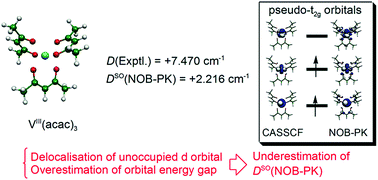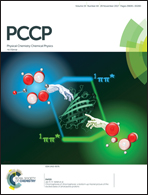Behaviour of DFT-based approaches to the spin–orbit term of zero-field splitting tensors: a case study of metallocomplexes, MIII(acac)3 (M = V, Cr, Mn, Fe and Mo)†
Abstract
Spin–orbit contributions to the zero-field splitting (ZFS) tensor (DSO tensor) of MIII(acac)3 complexes (M = V, Cr, Mn, Fe and Mo; acac = acetylacetonate anion) are evaluated by means of ab initio (a hybrid CASSCF/MRMP2) and DFT (Pederson–Khanna (PK) and natural orbital-based Pederson–Khanna (NOB-PK)) methods, focusing on the behaviour of DFT-based approaches to the DSO tensors against the valence d-electron configurations of the transition metal ions in octahedral coordination. Both the DFT-based approaches reproduce trends in the D tensors. Significantly, the differences between the theoretical and experimental D (D = DZZ − (DXX + DYY)/2) values are smaller in NOB-PK than in PK, emphasising the usefulness of the natural orbital-based approach to the D tensor calculations of transition metal ion complexes. In the case of d2 and d4 electronic configurations, the DSO(NOB-PK) values are considerably underestimated in the absolute magnitude, compared with the experimental ones. The DSO tensor analysis based on the orbital region partitioning technique (ORPT) revealed that the DSO contributions attributed to excitations from the singly occupied region (SOR) to the unoccupied region (UOR) are significantly underestimated in the DFT-based approaches to all the complexes under study. In the case of d3 and d5 configurations, the (SOR → UOR) excitations contribute in a nearly isotropic manner, which causes fortuitous error cancellations in the DFT-based DSO values. These results indicate that more efforts to develop DFT frameworks should be directed towards the reproduction of quantitative DSO tensors of transition metal complexes with various electronic configurations and local symmetries around metal ions.



 Please wait while we load your content...
Please wait while we load your content...